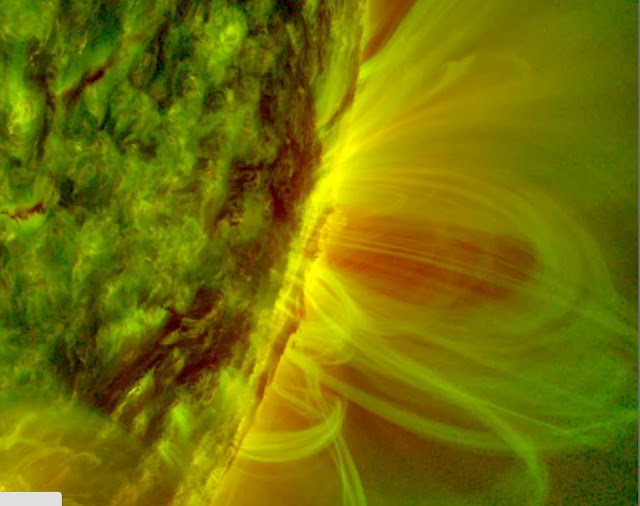

| Visitors Now: | |
| Total Visits: | |
| Total Stories: |

| Story Views | |
| Now: | |
| Last Hour: | |
| Last 24 Hours: | |
| Total: | |
Solar Flux Rope Formation Seen For The First Time
The NRL team made their discovery using high-resolution images from the Atmospheric Imaging Assembly (AIA) aboard NASA’s Solar Dynamics Observatory (SDO) and from the NRL-developed Sun Earth Connection Coronal and Heliospheric Investigation (SECCHI) telescopes aboard NASA’s Solar Terrestrial Relations Observatory (STEREO).
This movie shows a blended 131 and 171 angstrom view of flux ropes forming and erupting.
(Photo: SECCHI Team /NRL/NASA)
These flux ropes have been seen with coronal mass ejections, or CMEs, before, but scientists had argued for years about whether the flux ropes formed before the CME or were formed on-the-fly as the eruption occurred. The answer will determine whether the dominant mechanism for CMEs is plasma instability or changes in the magnetic field connectivity via magnetic reconnection, respectively. The observations made by visiting scientist Dr. Spiro Patsourakos, and NRL researchers Drs. Angelos Vourlidas and Guillermo Stenborg clearly reveal that the flux rope forms before the CME occurs. Their results are published in the Astrophysical Journal issue of February 20, 2013.
(Photo: SECCHI Team /NRL/NASA)
In observations from July 18, 2012, the NRL team observed a small burst of light off the West limb of the sun. These flares of light are usually the evidence of an eruption of solar material, in a CME. But the July 18th burst of light was not a CME. As the scientists continued their observations, they saw magnetic field lines that twisted and kinked to form slinky shapes. These magnetic field lines were filled with a charged gas called plasma, at a temperature of ten million degrees. Aided by the extreme ultraviolet images from the AIA, the NRL scientists saw, for the very first time, the formation of the flux rope. On June 19, they saw another solar flare from the same region. In these observations, the flux rope’s connection to the sun was severed and the magnetic fields hurled into space forming a fast CME in excess of 1000 km/sec.
The ability to observe these flux ropes will allow scientists to better predict when CMEs might occur. Since CMEs have a major effect on space weather, being able to predict the CMEs is very important because of their potential impact on military and civilian space and communication systems.
For decades, scientists have explored the idea of flux ropes. In the 1970s, plasma physicists proposed that there were coils of magnetic field lines present when solar flares were birthed. Then in 1995, when NRL’s Large Angle and Spectrometric Coronagraph (LASCO) launched aboard the ESA/NASA Solar Heliospheric Observatory (SOHO), NRL scientists were able to see the flux ropes inside CMEs in the outer corona. But it was a challenge to determine where the related flux ropes formed because they are expected to be small close to the surface of the sun, where they are difficult to see among all the other structures in the corona.
“We have stumbled upon the ‘Holy Grail’ of solar eruptions.This observation resolves the long-standing uncertainty about the dominant mechanism behind CMEs. It appears that CMEs are caused by the loss of equilibrium of a preformed flux rope structure”, says Angelos Vourlidas, one of the co-authors of the paper.
At the time of the July 18 eruption, NASA’s SDO cameras had the perfect angle to look directly down the center of the flux rope, giving scientists a view of what looked exactly like the slinky drawn by theorists for decades. In addition, the AIA cameras captured imagery like no other cameras are able to do with light at the 131 Angstrom wavelength. This view shows the solar material heated to temperatures of 10,000,000 degrees. Surprisingly, the flux rope was invisible in images at other wavelengths, used regularly for Space Weather analysis. Those wavelengths correspond to cooler (below 2 million degrees) temperatures, however.
(Photo: SECCHI Team /NRL/NASA)
Having multiple telescopes aided the researchers greatly as they looked at the July 18 flux rope. With the STEREO spacecraft looking at the sun from a different vantage point than SDO, the researchers were able to unravel the 3-D structure of the flux rope and verify that it was indeed a kinked slinky.
Armed with the knowledge of the connection between this one flux rope and CME, the NRL scientists are focusing on images of the hottest plasmas for other examples of flux ropes, knowing that they can help them refine their theories and understanding of CMEs.
Naval Research Laboratory



